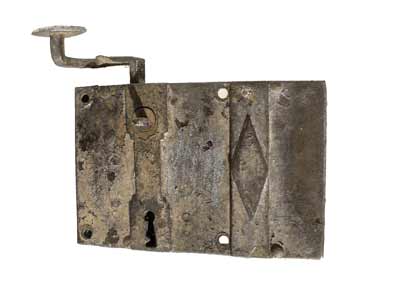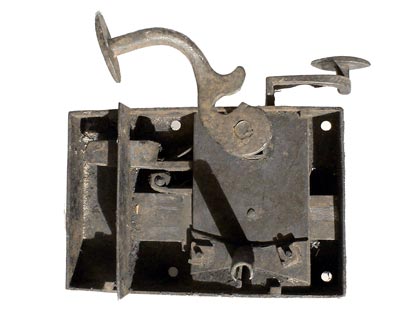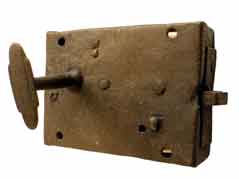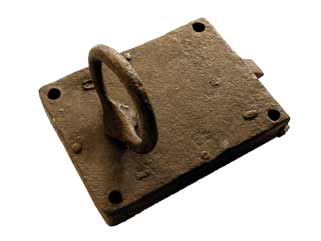Reinhold Rademacher
It was under Dutchman Reinhold Rademacher (1609-1668) that fine metalwork came to dominate the industry. Transferring his entire production from Riga in what was then Livland (a Baltic region until 1918) to Sweden in the summer of 1656, he made his entrance into Tunafors bearing a Royal Charter from Karl X to make preparations for the establishment of a broad-based ironwork industry.
The word ‘manufacture’ comes from the Latin manus (hand) and factum (accomplishment).
With the Royal Charter in his hand, Rademacher was able to create an entire town, with workshops by the Tunafors and Torshälla falls. It wasn’t long before the areas known as Carl Gustafs Stad were also incorporated. These communities were largely populated by smiths and soldiers called in from Germany and Livland. Manufacturing was multifaceted under Rademacher’s proprietorship, including locks and keys as well as door fittings, rifle locks and barrels, complete rifles, muskets, spurs, sword hilts, scissors, pans, iron and brass wire, and much more. The work was done both by craftsmen and industrially, often with very advanced division of labor.
 |
| Door lock, rim lock (18th C). Photo by the author. |
 |
| Door lock, rim lock (18th C). Photo by the author. |
The craft of fine ironworking came to be known as locksmithing. The material, iron, was forged either hot or cold. The final locks were normally finished off with a file.
Of the 72 craftsmen working at the forge in 1622, two were “Door-Locke Smythes” and eleven were “Outer Locke Smythes.”
Although these locksmiths mainly made locks and keys, they were also known to make door fittings, rifle components, and other items.
In 1662, the Council of the Realm issued rates for Rademacher’s products, stating precisely what the locksmiths were to produce in one week
The “Door-Lock Smythe,” in the space of one week, was expected to be able to make “8–10 common black door lockes, 5–6 black double door lockes, 4 tin-plated ditto, 8–10 black coffer or chest lockes and 1 large tin-plated door locke.”
Reinhold Rademacher was also a keen wholesaler, and sold the wares produced by his workshops and factories to ironmongers or wholesale dealers in Stockholm. But first he tried selling his products directly to customers, through stalls and shops owned by the company in Eskilstuna. He also had his own stall in Stockholm, where he competed with the local wholesalers.
After the death of Rademacher, ironsmithing declined in Eskilstuna and did not pick up until the mid-1700s, when two major companies – Carl Gustafs Stål och Manufaktur (Carl Gustaf’s Steel and Ironworks) and Tunafors manufakturverk (Tunafors Ironworks) – began competing for customers.
 |
| Chamber lock, rim lock (18th C). Photo by the author. |
Samuel Schröderstierna and his successors
The next important event in the town’s development was overseen by state mining commissioner Samuel Schröderstierna (1720–1779). In 1753, he was appointed director of fine metalwork in Sweden.
In 1771, a royal proclamation was issued, offering privileges that paved the way for a new smithing community, or more accurately an artisan town – Eskilstuna Fristad – incorporating other parts of Carl Gustafs Stad. Eskilstuna Fristad’s first governor was Samuel Schröderstierna. By 1786, there were 69 masters, 68 journeymen and 99 apprentices operating in Eskilstuna Fristad, and the breadth of their output was astounding. Besides all kinds of padlocks and door locks of every shape and size, the manufacture of which took twelve masters, there were hundreds of other items, including:
Door fittings, bridle bits, stirrups, household goods and kitchenware, irons, scissors, knives, rapier blades, foils, scythes, chaff knives, tools, garden implements, saw blades, wall clocks, hooks, lamps, candlesticks, writing implements, iron beds, spectacle frames, weights, chains, nails, and much, much more.
Schröderstierna was succeeded on his death by mining engineer Samuel Sandels (1724–1784) and undersecretary Johan Liljencrantz (1730–1815). They were later joined on the board of Eskilstuna Fristad by assessor Bengt Quist (1726–1799) and state mining commissioner and metallurgist Sven Rinman (1720–1792).
 |
| Chamber lock, rim lock (18th c). Photo by the author. |